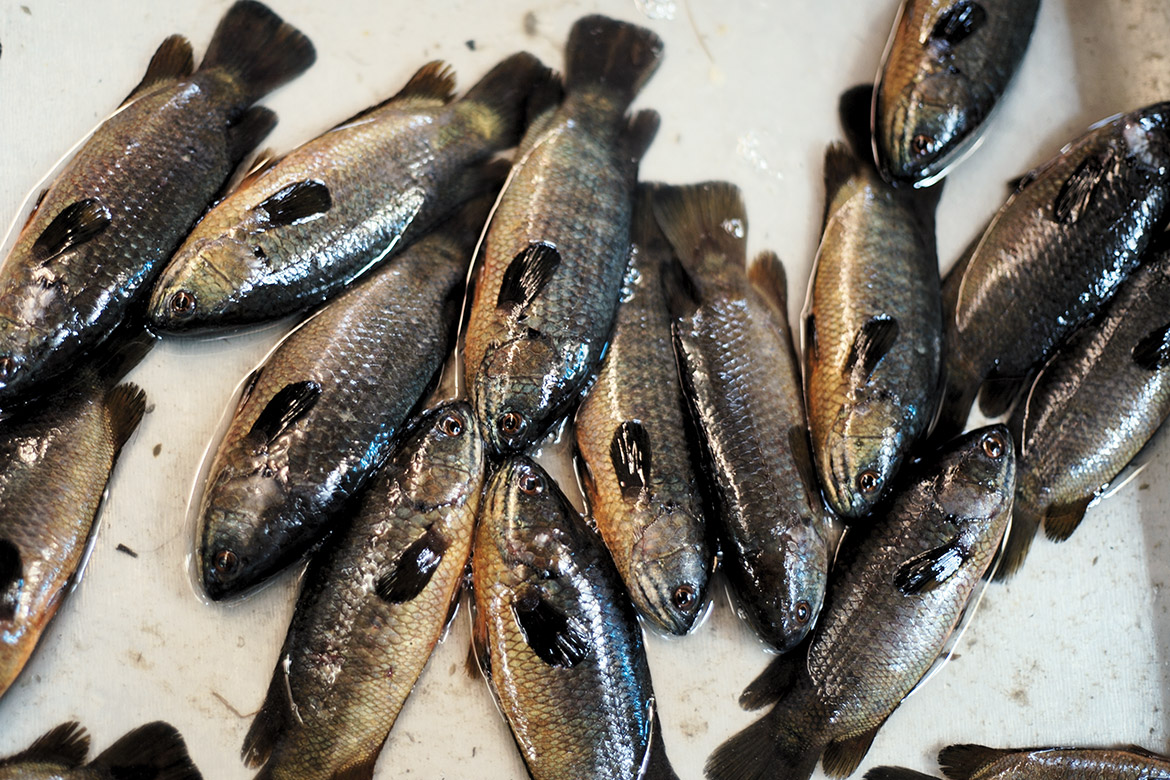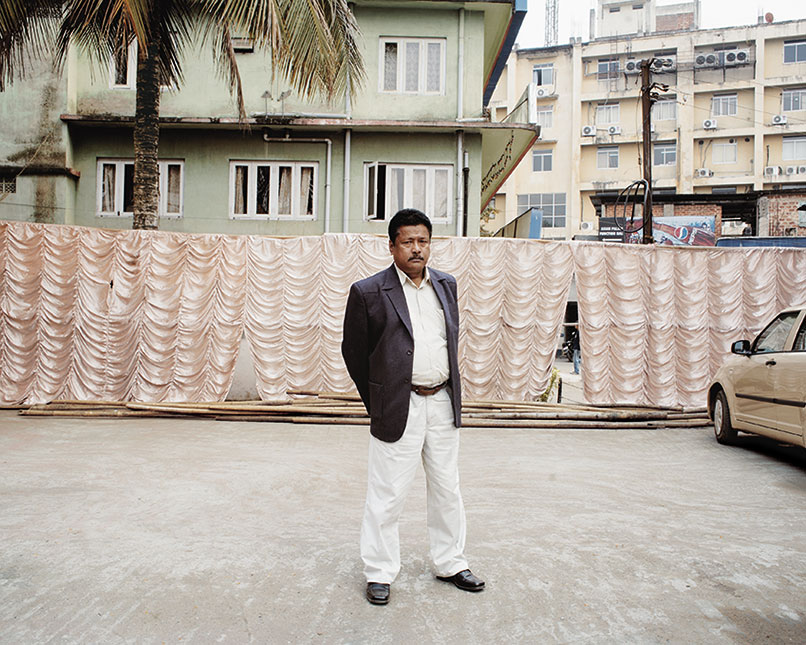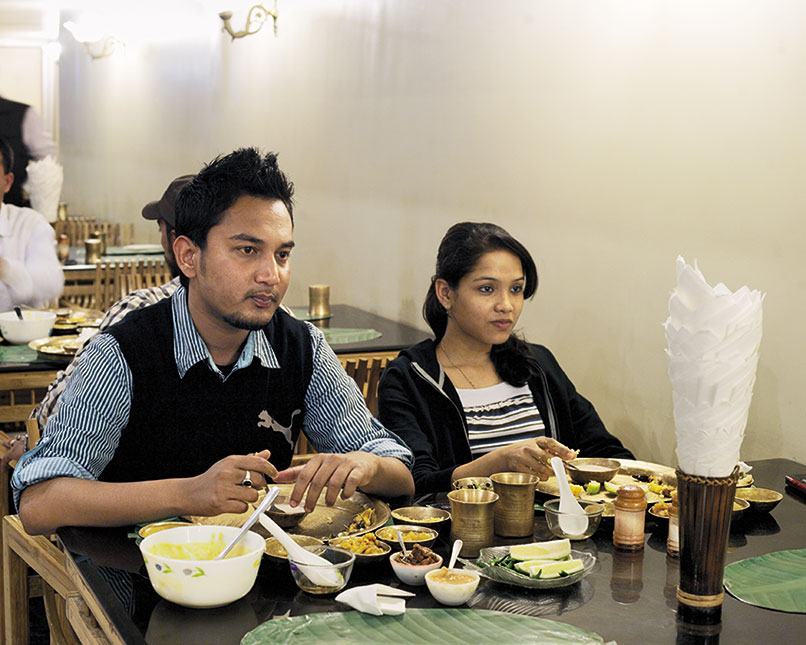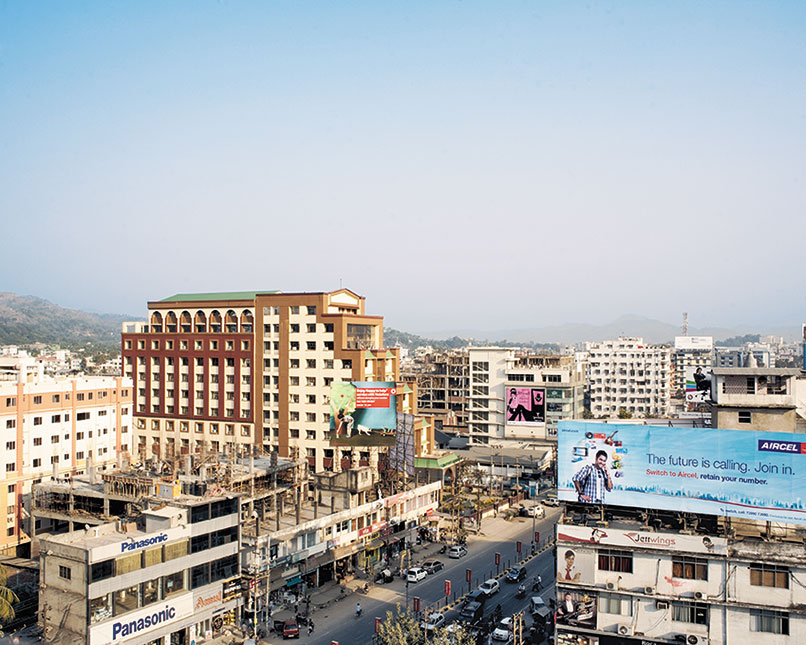
#North-East
Photographs: Tenzing Dakpa
In 2009, when British celebrity chef Gordon Ramsay visited the Northeast as part of his “Gordon’s Great Escape” television series, Atul Lahkar, 40, a celebrity chef known in his native Assam, was approached to help out. He deliberated how to best represent his cuisine. So he decided to organise a chilli eating competition to showcase some local talent.
In a busy hall, Ramsay watched gob-smacked as Anandita Dutta Tamuly, a buxom woman in her 20s, downed 49 Assamese bhut jolokia chillies in two minutes. Immediately after, Tamuly dissolved into tears of disappointment; previously, she’d eaten 60 in two minutes, making her a serious contender for a Guinness World Record. Doubling over in excruciating pain may have been a more understandable reaction. Thebhut jolokia, a vermillion-coloured chilli pepper, similar in size and form to the jalapeño, of which it’s 200 times hotter, weighs in as the second hottest chilli in the world. Most people can’t even handle a nibble.
But it wasn’t the unusual endurance of Tamuly that Lahkar wanted to convey. Rather, in capitalising on one of the more memorable aspects of his food culture, Lahkar says he wanted to communicate that Assamese (and by extension Northeastern) cuisine has a unique identity. Lahkar comprises a small Guwahati-based culinary brigade actively working to popularise ethnic Northeastern food.

In the river port city of Guwahati, the gateway to the Northeast and the region’s trading hub, crumbling bungalows with verandas and overgrown gardens are increasingly becoming overshadowed by modern office complexes which have sprung up in the last decade.
A traditional culture of eating Assamese food at home meant that Assamese dhabas, while sometimes very good, were eclipsed by the city’s myriad Chinese and North Indian eateries. According to many, only one establishment was known to serve Assamese food in a restaurant setting. But even then, Paradise, which opened in 1984, also has Chinese and Indian dishes on its menu. More recently, the KFCs and fast-food chains have muscled their way in, absorbing young diners or what Lahkar refers to as “the pizza generation.”
Across the Northeast, Lahkar observed too that people would present their dinner guests with Indian and Chinese dishes. When it came to serving ethnic food, Lahkar says people were “suffering some kind of inferiority,” therefore, they’d avoid serving it at home, let alone in a commercial setting. “This is a problem,” he says. In being dominated by other cuisines, he says, “slowly my people forgot about their own cuisines.”
So fifteen years ago, intent on starting a restaurant to project ethnic cuisine into the limelight, Lahkar took up a cooking hobby in a big way. After learning the basics of cooking in Chennai, back in Guwahati, he worked as a restaurant manager and from 1995, spent seven years visiting all the Northeastern states. He says he “roamed from door to door” collecting the largely unrecorded, oral recipes from different tribal villages. This was no small task as the region is hugely diverse and has over 200 ethnic groups. He amassed more than 1 000 recipes during this time.
In 2005, the eatery, Gam’s Delicacy, opened in Ganeshguri in the heart of Guwahati’s commercial district. Its opening heralded a new phase in the city’s food culture. With a drive to promote ethnic Northeastern cuisine, a handful of restaurateurs, and as many restaurants began to emerge. And the timing was right. The boomtown, which receives more visitors that any other Northeastern destination, had given rise to a growing market. Today, it’s a well known few that are in operation – Gam’s Delicacy, Khorikaa (which Lahkar opened in 2007) and Maihang. Signifying a newfound confidence, these establishments offered authentic bigger menus in stylish digs – the décor pulling from a heritage of bamboo widely used in the region. Other eateries, serving up Manipuri, Naga and pan-Northeastern food have also cropped up in recent years.
Lahkar helped conceptualise the menu at Gam’s Delicacy, and while he says it’s the “first time a complete Assamese menu was introduced,” as evidenced in the main Assamese dishes – khar (an alkaline dish) tenga(a sour dish), khorika (barbequed meat) and pitika (a mashed dish) – and the retention of mustard-oil flavoured recipes, he’s given the food an edge. Drawing from his recipe-collecting days, Lahkar has introduced ethnic elements into mainstream eating which were once sidelined by what dictated the hallmark of Assamese cuisine, Brahmin food.

According to Ranoj Pegu, a social activist and proprietor of Maihang, another such ethnic food restaurant which opened in 2009, meats like pork, beef and fowl – freely consumed in what was largely an animistic society were forbidden as Vaishnavism influenced a nascent Assamese society in the 14th century.
But gradually, since the 1970s, he says, “ethnic groups, hitherto considered part and parcel of greater Assamese community, started asserting their own identities.” As a result, their distinctive cultures and food habits “came back into the limelight.”
Because of its geographical proximity to Southeast Asia, food cultures of the Northeast are similar to those of countries like Thailand and Myanmar, and have centred on grains, meat and fish, explains Pegu.
The dried spices and liberal use of oil, widespread in North Indian cooking, are absent here. Broadly speaking, the region’s cooking methods – smoking, boiling, steaming and frying (with little oil) – meant traditional dishes could be reworked at Gam’s Delicacy, says Lahkar.
Gam’s Delicacy is a bustling eatery and it’s often filled with a younger crowd. It has the requisite bamboo furnishings, bell metal cups and plates (to release iron into the food, explains Lahkar) and kitsch tablemats of laminated green banana leaves.
The food here is simple-flavoured, fresh fare. The introduction of meats like pork, for example the porkkhorika, a knockout dish of bite-size knobs of smoked pork with a generous cut of fat, blackened and slightly crackly due to the cooking process, were a first at a mainstream eatery. Other innovations such as using sesame seeds with meat, are a nod to the Karbi tribe of Assam and the Khasis of Meghalaya. Boiled fish too is an ethnic variation, whereas Assamese Brahmins fry or barbeque their fish.
A stone’s throw from Gam’s Delicacy lies Ganeshguri wet market on busy G S Road. A trip here is an introduction to the fresh ingredients integral in Northeastern cooking. Lahkar, an effusive character, also presents television cooking shows – his current show, showcasing different tribal villages and their cooking habits, is playing on the regional channel NETV. Lahkar plays the part of the celebrity chef well. Today, he has donned faux-cowboy boots, a fitted, check shirt and a waist coat, and looks somewhat out of place in the open-air market, but he darts about, pointing out ingredients with easy familiarity: ou tenga (or “elephant apple,” named so because of elephants’ fondness for this vegetable), fresh turmeric, squat local lemons shaped like cucumbers, banana flowers and an array of fish, both dried to use in chutney and fresh. The many medicinal herbs with names like Indian pennywort have already been cleared out by midday. Cooking with seasonal ingredients is key. And the time for bamboo shoots and the bhut jolokia won’t roll around until later this year.

Pegu, a sturdy man of 47, while sipping jasmine tea at his central Guwahati establishment, Maihang, is explaining why he’s popularising ethnic Northeastern cuisine: to preserve the diverse tribal produce and food customs. The countless, beneficial varieties of indigenous grains, for example, are “just simply disappearing.” Pegu speaks with a deep understanding and appreciation for not just grains, but also for the well of “tastemaker” ingredients artfully employed by the tribal “hill people” from varieties of known spices like chilli and ginger, to the medicinal herbs to the methods of preservation including fermented foods like soybean, fish and bamboo shoots.
“To save them, we will have to popularise them,” he says, pointing out that Guwahati’s residents only know what raw ingredients are available in the city. He does not extend the popularisation of ethnic cuisine to the meat delicacies that are obtained through hunting and gaming. “[We] need to conserve for biodiversity. There is enough commercial meat, no need to hunt deer.” The joke he proffers, that people in the Northeast consider anything that moves to be food, still holds some truth.
Many tribal villages in Nagaland and Arunachal Pradesh still practice a hunting culture. A senior official with the Indian Administrative Services, who did not want to give his name, says deer is a regular feature at the wet market in Dimapur, Nagaland. It’s just kept under wraps, hidden under vegetables. Flogging this invisible ware exacts the surreptitious jargon you might expect of a drug-dealer: “Do you want? I have.”

The menu at Maihang is more experimental than at Gam’s Delicacy. The kind of things on offer include a sticky, lightly vanilla scented Manipuri black rice, dishes using a local variety of sichuan pepper and meats with fermented soybean, commonly used by the Sumi Naga tribe; its pungent smell can be likened to gorgonzola cheese. Maihang accepts special requests like the Khasi fried rice, jadoh. Pork fat, traditionally used in this dish, can be supplemented with pig’s blood, a delicacy that customers can also order in advance.
“To make [our] food successful, [it] needs to be commercially successful,” says Pegu. And a step towards this, he says, is culinary standardisation, much in the same way that Thai or Japanese cuisines are. “We need an identity of our own food.”
In consolidating one, Pegu’s pushing to use common names which are acceptable to all. For example, he says, akhoni (what Sumi Nagas call fermented soybean), mejenga (sichuan pepper), and even raja mirchaover bhut jolokia (which are part of the same family), are starting to take root.
Both Pegu and Lahkar believe that ethnic cuisine has a strong selling point: it’s healthy. And a growing awareness about health, says Lahkar, has resulted in greater curiosity about his food.
“Though my food is basically organic and basically healthy, it has medicinal values so that’s why I think people want to know about our cuisines,” says Lahkar. “The organic food, the wild herbs, the aromatic herbs, the medicinal herbs will be the identity of our people,” he says.
But a concerted push for a food identity can be viewed as an expression of cultural pride in a region traditionally sidelined in the national imagination. “People in the Northeast have been denied representation by the mainland for so long,” says Aruni Kashyap, a Guwahati based writer. “Any representation of culture becomes a certain assertion of identity.”

“These restaurants are quite interesting because there are residual feelings of nationalism, feelings of separatist ideology, whatever you want to call it, which is now to say, ‘ok we can’t fight you anymore but we can eat differently,’ ” says sociologist Sanjay Barbora, referring to Assam’s modern-day separatist movements including armed insurgencies; in the 1990s, a number of surrendered militants returned to mainstream society.
“Partly, the grand narrative is, you are different from the rest of India and your food is also different. It’s about the politics of taste. Politically your food is different,” he says.
A subtext to this initiative to reinvent ethnic food, he explains, is that people “are also kind of coming to terms with urbanisation, people moving away from the rural areas, people having to leave the roots as it were, and in a way this is also recording and presenting food as your grandmother used to cook it.”
In a couple of years, Lahkar plans to start a cooking institute in Dibrugarh, Assam. “I’m doing all the cooking. If I want to grow this food industry, if indigenous cuisine will move, we need skilled people.”
And in February this year, Lahkar opened what he says is the city’s first fine-dining ethnic Northeastern restaurant. King Chilli, named so in deference to the bhut jolokia, is housed in a high-end hotel and he hopes to expand it as a chain. The menu includes a range of meat dishes cooked with king chilli, different rice preparations including thola bhat (steamed in banana leaf), dishes with medicinal herbs, black dal recipes and on Saturdays he serves rice beer brewed at a local village. He’s also included more unusual seasonal tribal dishes, and in March and April, for instance, a side dish of red ant eggs is available.
“Northeast food is most important, more than marriage,” Lahkar says jokingly. Then on a more serious note he says why he’s duty-bound. “If I am not promoting my cuisine, who will?”
